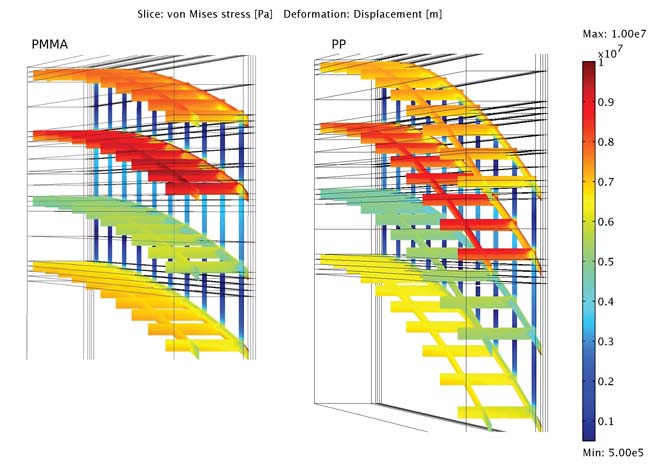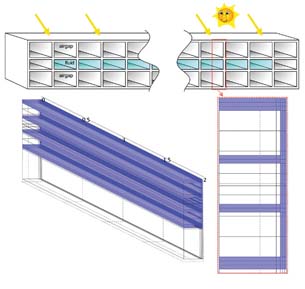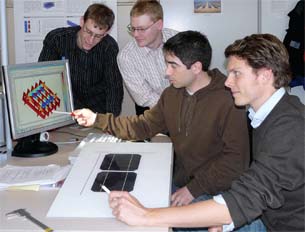New Solar Collector Materials Modeled with COMSOL Multiphysics
Simulation that Will Change the World, Second Place: Researchers at the Fraunhofer Institute for Solar Energy Systems use COMSOL to model characteristics of new polymeric materials.
Latest News
December 1, 2009
By Karl-Anders Weiss
Since an estimated half of fossil fuels burned are used for heating purposes, there is a huge potential in replacing them with renewable energy sources such as solar collectors. Today’s standard collectors use copper or aluminum as the energy-absorbing material, but consider that if we were to meet just 1 percent of the world’s heating energy with conventional solar collectors, it would require 22 million tons of copper. The worldwide output of copper in 2006 was 17.6 million tons. Add to that recent price increases in metals and there’s a clear impetus to examine much less-expensive polymers as an alternative.
 The Von-Mises stresses within a polymer-based solar collector at a normal inlet temperature of 350K can vary widely depending on the material. Here a comparison of the stresses and deformation between polymethyl methacrylate (left) and polypropylene (right) is shown. |
However, polymers don’t have the same ability to withstand high temperatures as metals, so we need completely new designs for polymer-based solar collectors. In studying new concepts we are starting from scratch and use modeling to understand virtually every aspect of an energy system’s operation including heat transfer due to fluid flow, heat-induced structural deformation and stress, plus the mass transport of water through barriers. COMSOL Multiphysics provides an excellent platform that allows us to examine all of these within one easy-to-use environment and to optimize system operation before we start building prototypes.
Design Optimization for Collectors
The use of polymeric materials in solar energy applications offers many advantages. First, of course, is its price compared to today’s collector materials. Next, polymers offer great freedom in terms of design—we can develop new collector layouts that would be impossible using conventional materials. For example, with an extrusion process it might be possible to mass-produce complex geometries in lengths of kilometers and bring economies of scale to bear. Further, polymers allow the manufacture of collectors that are lighter in weight than those of metal.
 This diagram shows a possible geometry for a solar absorber made of polymer materials. |
Polymeric materials have a low intrinsic thermal conductivity. This, however, can be compensated for by optimizing collector geometries with the goal of a layout that assures homogenous flow and maximized contact area between the absorber and the heat-transfer fluid. With solar collectors, heat transfer is certainly dependent on a material’s thickness and heat conductivity. But an even more predominant effect can be the heat-transfer coefficient between the fluid and the wall, which is determined by the fluid dynamics in the vicinity of the surface, and they depend on the surface’s shape. Because polymeric materials can have almost any form, we want to optimize a polymeric absorber’s shape so that heat transfer by convection overcomes the lack of heat conductivity.
Advantages of design optimizations are best described by the results of adding an additional plate as absorber into the design, which could increase the internal conductance from 95 W/m2K to 540 W/m2K.
One possible layout (above) for a thermal absorber was based on multi-wall sheets where the heat-transfer fluid passes through channels surrounded by air to provide heat insulation from the environment.
Collector Stress Levels Analyzed
However, collectors deform when heated, so stress distribution and deformation represent potential risks for their stability and durability, especially at mechanical connection points. We want to estimate a product’s useful lifetime due to mechanical stresses that arise during both normal operation and during stagnation, the worst-case situation when the energy storage system is no longer able to accept heat from the collector.
We set up a COMSOL model that accounts not only for the temperature distribution that varies with the position of the absorber layer but also for other factors that affect the temperature level including the amount of irradiance, inlet temperature, and the collector’s thermal losses. This temperature data enables the determination of the collector’s deformation and mechanical failures reducing the service lifetime.
 Fraunhofer researchers studying the COMSOL simulation results are (left to right) Georg Mülhöfer, Karl-Anders Weiss, Jochen Wirth, and Philip Hülsmann. Steffen Jack is missing from photo. |
Humidity Transport in PV Modules
While the previous model dealt with solar collectors, polymers also play a role in improving the cost efficiency of photovoltaic (PV) solar modules. These consist of a front cover of glass, encapsulated solar cells, and a back-sheet, which is usually made of polymeric materials. These polymeric back-sheets and encapsulants provide a barrier to keep humidity, atmospheric gases, and pollutants away from the silicon solar cells and protect them mechanically.
The ingress of humidity is a serious reason for their degradation, which can hardly be measured without physically destroying the module. Therefore, we work on developing measurement technologies and model the humidity transport.
Thanks to our modeling, we can compare different polymeric collector geometries and materials for various energy carriers to reach an optimized collector design in terms of efficiency and price. We have also confirmed that our design is as efficient as conventional collectors and that the mechanical stability is sufficient if the collector is constructed properly. Our next steps are to model longer time periods to guarantee sufficient durability for our future partners in industry.
More Info:
COMSOL
Karl-Anders Weiss earned his degree in physics and economics at the University of Ulm, Germany. He has been with the Fraunhofer Institute for Solar Energy Systems focusing on durability analysis and environmental engineering since 2005. Send comments about this article to [email protected].
Subscribe to our FREE magazine, FREE email newsletters or both!
Latest News
About the Author
DE’s editors contribute news and new product announcements to Digital Engineering.
Press releases may be sent to them via [email protected].






